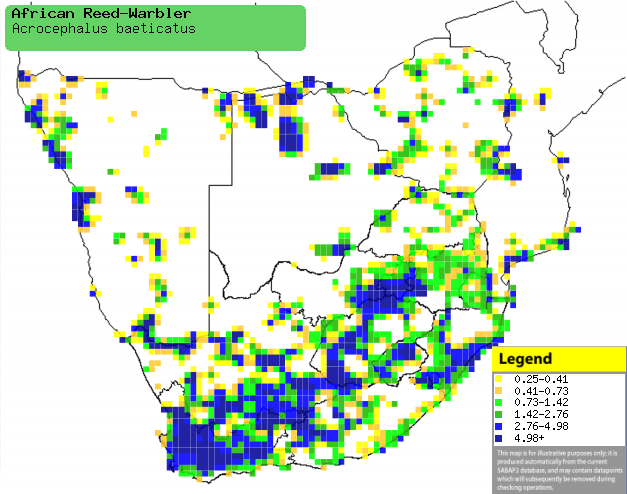|
Acrocephalus baeticatus
(African reed-warbler, African marsh-warbler)
Kleinrietsanger [Afrikaans]; Niini (generic term for
warblers and eremomelas) [Kwangali]; Soamahlaka-sa-mefero [South Sotho];
Timba (generic name for cisticolas and warblers) [Shona];
Kortvleugelkarakiet [Dutch]; Rousserolle africaine [French];
Gartenrohrsänger [German]; Rouxinol-dos-caniços-africano [Portuguese]
Life
> Eukaryotes >
Opisthokonta
> Metazoa (animals) >
Bilateria >
Deuterostomia > Chordata >
Craniata > Vertebrata (vertebrates) > Gnathostomata (jawed
vertebrates) > Teleostomi (teleost fish) > Osteichthyes (bony fish) > Class:
Sarcopterygii (lobe-finned
fish) > Stegocephalia (terrestrial
vertebrates) > Tetrapoda
(four-legged vertebrates) > Reptiliomorpha > Amniota >
Reptilia (reptiles) >
Romeriida > Diapsida > Archosauromorpha > Archosauria >
Dinosauria
(dinosaurs) > Saurischia > Theropoda (bipedal predatory dinosaurs) >
Coelurosauria > Maniraptora > Aves
(birds) > Order: Passeriformes
> Family: Sylviidae > Genus: Acrocephalus
Distribution and habitat
Occurs in Arabia and sub-Saharan Africa, where it is patchy
across the Sahel but with the bulk of its population spread from Sudan
through the DRC to Zambia, Angola and southern Africa. Here it generally prefers
habitats either in or on the border of water bodies, such reedbeds of Bulrushes
(Typha capensis), sedges (Juncus, Cyperus and Scirpaceus).
It may also occupy shrubs and grasses near rivers, moving into drier habitats in
the non-breeding season.
|
 |
|
Distribution of African reed-warbler in southern
Africa, based on statistical smoothing of the records from first SA Bird
Atlas Project (©
Animal Demography unit, University of
Cape Town; smoothing by Birgit Erni and Francesca Little). Colours range
from dark blue (most common) through to yellow (least common).
See here for the latest distribution
from the SABAP2. |
Food
It mainly eats insects, plucking them from leaves and
branches or catching them in flight.
Breeding
- Monogamous, sometimes facultative cooperative breeder; in a study in
Namibia 88% of 65 breeding pairs did not have any helpers, the remainder had
only one unrelated helper.
- The nest is a deep cup built of reed leaves and grass, lined with finer
plant material. It is typically attached to the stems of reeds, grasses,
sedges, arum lilies (Zantedeschia), occasionally in the drooping
branches of a willow (Salix).
- Egg-laying season is from September-April, peaking from October-January.
- It lays 2-3 eggs, which are incubated by both sexes for 12.5-14 days.
- The chicks are cared for by both parents and sometimes the helper,
leaving the nest after about 12-13 days.
Threats
Not threatened.
References
-
Hockey PAR, Dean WRJ and Ryan PG 2005. Roberts
- Birds of southern Africa, VIIth ed. The Trustees of the John Voelcker
Bird Book Fund, Cape Town.
|
